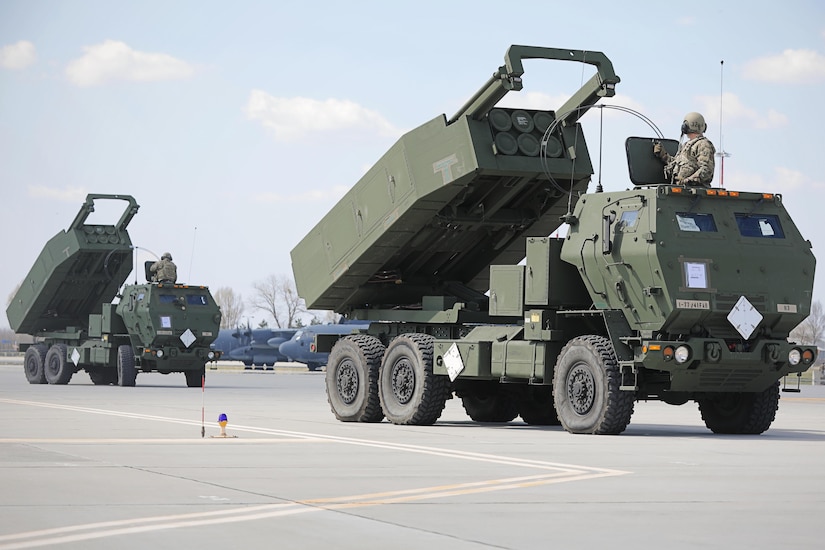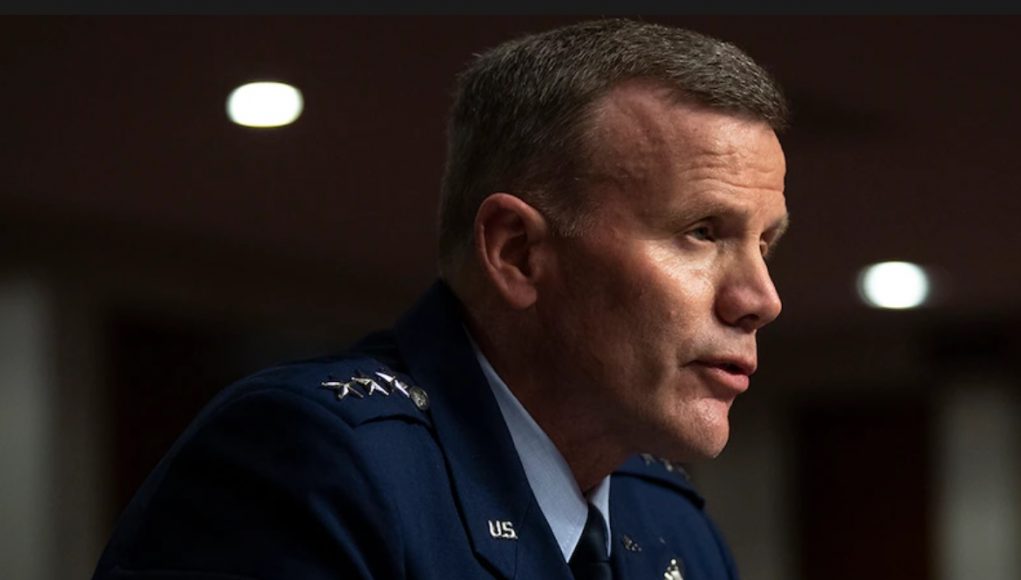Generals provided testimony in US Congress regarding tensions on the Russia-Ukraine border and the ability of U.S. allies to move large numbers of forces quickly over great distances.
Air Force Gen. Tod D. Wolters, commander of the U.S. European Command (USEUCOM) and Supreme Allied Commander in Europe (SACEUR), and Army Gen. Stephen R. Lyons, commander of the U.S. Transportation Command, testified at a Senate Armed Services Committee hearing to review the fiscal 2022 defense authorization request and the Future Years Defense Program.
The current NATO security posture in Europe is strong, yet challenged by Russia’s actions in the vicinity of Ukraine, said Wolters, adding that America’s allies and partners in Europe remain a key strategic advantage.
“NATO remains the strategic center of gravity and the foundation of deterrence and assurance in Europe. Everything we do is about generating peace,” said Wolters. “We compete to win. We deter, and, if deterrence fails, we’re prepared to respond to aggression with the full weight of the transatlantic alliance.”
Wolters noted that NATO has a robust exercise program. This summer, NATO will conduct Defender-series exercises composed of some 30,000 U.S. service members, allies and partners.
That exercise will demonstrate NATO’s ability to move massive forces over large swaths of Europe at speed and at scale, he said.

Wolters also mentioned the addition of 500 soldiers to U.S. Army Garrison Wiesbaden in Germany.
These troops will be made up of field artillery; composite air and missile defense; intelligence, cyberspace, electronic warfare and space; aviation and a brigade support element. The Theater Fires Command will improve readiness and multi-national interoperability by integrating joint and multinational fires in exercises and operations, in support of U.S. Army Europe and Africa, said Army Col. Joe Scrocca, the spokesman for U.S. Army Europe and Africa, in a separate statement today.
“The Theater Fires Command and Multi-Domain Task Force in Europe will enable U.S. Army Europe and Africa to synchronize joint fires and effects, control future long-range fires across all domains, and will create more space, cyber and electronic warfare capabilities in Europe,” Scrocca said.
Lyons told senators that Transcom’s mission is to project forces globally on land, air and sea, including to support the upcoming NATO exercises.
U.S. and British reconnaissance aircraft are intensively monitoring eastern Ukraine, Crimea, and Russia’s Black Sea coast amid fears of a renewed Russian offensive.
T-INTELLIGENCE : RUSSIA’S 2021 BEAR SCARE
In the past month, Russia has moved over 14,000 soldiers and a vast array of capabilities, including Iskander ballistic missiles, tanks, howitzers, and thermobaric rocket launchers towards the Ukrainian border. Russia then launched thousands of snap exercises countrywide and established new field camps. One staging ground in Voronezh oblast, hosting over 400 military assets, has all the hallmarks of a logistics node that could support a line of communication into Ukraine.

Russia’s recent troop movements have alarmed the international community that fears a reignition of the war in eastern Ukraine or, even worse, the opening of a new front from Crimea.
Operating from international and Ukrainian airspace, U.S. and British drones and other specialized aircraft collect updated, real-time intelligence on Russia’s nefarious activities. Given the types of aircraft visible on openly available flight trackers, the two NATO members primarily collect imagery (IMINT) and signals intelligence (SIGINT).
IMINT ON DEMAND: RQ-4 IS OUR “FORTE”
Operated by the United States Air Force (USAF), the RQ-4 Global Hawk drone is at the forefront of Washington’s ISR (Intelligence, Surveillance, and Reconnaissance) operations in the Black Sea region. Based in Naval Air Station Sigonella (Italy), the RQ-4 Global Hawk with registration number 11-2049, either callsign FORTE10 and FORTE11, conducts frequent flights over eastern Ukraine.
Th RQ-4 Global Hawk is a long-endurance unmanned aerial vehicle (UAV), meaning it has a 24 hour+ flight autonomy. Combined with hi-resolution cameras, the RQ-4 can provide a crystal-clear, live feed of Donetsk and Luhansk’s frontlines to decision-makers and commanders back at base. As seen in the screenshots attached, the RQ-4 loiters extensively and publicly over designated areas of interest.

While FORTE10 was a daily visitor of the region even before the latest escalation, its recent activities are likely connected with Russia’s troop build-up. In the screenshot below (11 April), the RQ-4 (now FORTE 11) was orbiting over the Kherson-Mariupol area, north of Crimea, after completing multiple passes over the frontline in Donbas.
The drone’s flight path is unusual and suggests that U.S. commanders are seriously considering that Russia might open a new front in the war against Ukraine and seize the Crimean canal.
Ukraine dammed the North Crimean Canal in 2014. As a result, the Russian-occupied Crimea lost nearly 90% of its fresh water supply, leaving it dry. While Moscow plans to solve this issue by re-routing four rivers into the Mezhgorny reservoir by 2024, many observers fear that Russia might use military action to seize the Crimean dam.
Besides the “daily FORTE”, there various other NATO country platforms surveilling the Black Sea region.
POSEIDON IS WATCHING
Best known for its submarine-hunting capabilities, the U.S. Navy’s P-8A Poseidon Maritime Patrol Aircraft (MAP) also packs a substantial ISR capability. Using its powerful APY-10 multi-mode synthetic aperture radar, the P-8A can detect, classify and track surfaced vessels. The P-8A Poseidon surveillance system also includes the MX-20 – a modular HD imaging system with large-aperture lenses for high magnification, laser-range finding, and laser illumination.
Besides IMINT, the P-8A can exploit emission from the electromagnetic spectrum. Thanks to its ALQ-240 Electronic Support Measure (ESM) suite, the P-8 can geo-locate and classify enemy radar emitters. On top of that, the P-8 can launch drones equipped with specialized sensors to detect submarines based on fluctuations in the Earth’s magnetic field.
This sensor fusion is invaluable to keep a watch on the Russian Navy’s activity around the Crimea peninsula and Krasnodar Krai. The Poseidon becomes an ever more relevant platform as Russia recently announced that it would deploy ten warships from the Caspian Sea into the Black Sea.
OLD TIMERS LISTENING IN: P-3C ORION AND ARIES II
The Poseidon’s predecessor platform, the P-3 Orion, is the U.S.’s other platform tasked with monitoring Russia’s build-up from an air-naval perspective. A rare occurrence, the P-3 acts as a force multiplier for the U.S. ISR efforts.
We have observed two P-3 variants operating in the area: the P-3C Orion and the EP-3E ARIES. While the Orion is an old airframe, it can still pull its weight in maritime intelligence collection and fulfil SIGINT duties.
The other variant observed is an evolution and conversion of the Orion, known as the EP-3E ARIES II (Airborne Reconnaissance Integrated Electronic System II). Operated by a crew of 22+ specialists, ARIES II provides near real-time tactical SIGINT and full-motion video intelligence to commanders. ARIES can also intercept human communications (Communication Intelligence/ COMINT) and exploit a wide range of electronic emissions from deep within enemy territory.
Plus, the EP-3E ARIES flight crew also brought some humor into the mix. During a flight around Crimea on 10 April, an ARIES II appeared on flight trackers with the callsign “AK47,” and claimed to be an “AirAsia” flight.

ELECTRONIC STALKERS: RC-135W RIVET JOINT FLIGHTS
The last but not least platform active in the area is the Royal Air Force’s RC-135W Rivet Joint, operated by the 51st Squadron from RAF Waddington. The RC-135W is an Electronic Intelligence (ELINT) aircraft that can monitor radars, communications, and other signals emitted by the Russian units in Crimea.
ELINT aircraft are particularly good at mapping out the enemy’s Electronic Order of Battle (EOB). EOB typically includes the identity, capability, operating details, and location of enemy threat emitters and their role within an integrated air defense network.
RC-135W aircraft have started regularly operating in the Black Sea in late February/early March. This is likely when the first signs of Russian troop movements became apparent to the American and British intelligence community. Two RC-135W aircraft (reg. ZZ666 and ZZ664) conducted the recon runs using at least four different callsigns – RRR7227, RRR7238, RRR7239 and RRR7240.
ISR PARTIES
Many of the aircraft listed have also operated simultaneously in the Black Sea theater. The tweet attached shows the airspace over the Black Sea on 6 April.
An RQ-4 UAV was completing its second orbit over Severomonsk, while the RAF’s RC-135W was active near the Kerch Strait. Outbound from Sigonella, a P-8A Poseidon was on its way to join to ISR party.
Another mentionable ISR party took place on 14 April and featured a different assembly of allied aircraft. A U.S. EP-3E Aries II from Souda Bay (reg. no. 16140) scanned Crimea’s southern coast for signals and other emissions. Further down south, a Turkish Navy ATR C-72-600 aircraft was patrolling the Black Sea’s midsection, making a rare appearance on flight trackers. The “no callsign” aircraft is the US Navy’s P-8A Poseidon (outbound from Sigonella) on its way for another mission over the Black Sea.
One of NATO’s few independently-operated RQ-4 Global Hawks was was also active in the region. However, the drone deactivated its transponder before we had the chance to screenshot it.
PREVENTING SURPRISES
ISR platforms such as those observed on flight trackers enable commanders and decision-makers to “see and hear” what the Russian military is preparing near Ukraine. These missions are critical to ensure that NATO will not be caught by surprise should Russia mount a new sneak attack.
While Russia’s build-up is at 2014-2015 levels and poses a credible threat, there is still no clear indication that Moscow intends to launch a new offensive in Ukraine.
T-Intelligence will continue to monitor the situation




